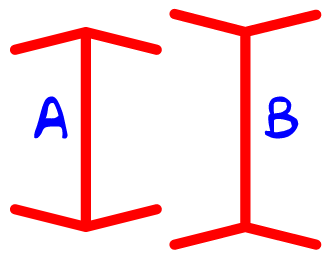Judging Length Explained
Some things seem different when they're not!|
In the case of the two red bars, the simple act of adding arrow heads and ends tricks the brain into misjudging size. This turns out to be particularly easy to do.
The overall size of object B is greater than that of A. This immediately tricks our brain into increasing the significance of B. Its close proximity to A seals the deal, and we will always choose B as the biggest. Use a ruler, however, and you will find no difference. |
 In bar A, the outward-pointing arrows rigidly define the size of the bar. In bar B, however, the opposite is true - the arrow flights loosely define the ends of the bar.
In bar A, the outward-pointing arrows rigidly define the size of the bar. In bar B, however, the opposite is true - the arrow flights loosely define the ends of the bar.